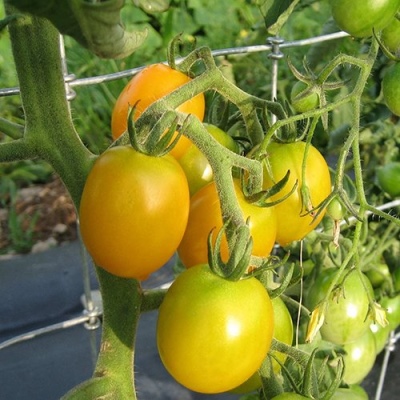
- Authors: Gavrish S.F., Morev V.V., Amcheslavskaya E.V., Degovtsova T.V., Volok O.A., Vasilyeva M.Yu.
- Year of approval: 2015
- Category: grade
- Growth type: indeterminate
- Appointment: fresh consumption, for pickling and preserving
- Ripening period: mid-season
- Ripening time, days: 110-115
- Growing conditions: for film greenhouses
- Bush size: tall
- Bush height, cm: more than 200
The tomato species introduced in the late 2010s can make good companions for gardeners. But they, like earlier varieties, must be studied carefully and carefully. Only in this case it will be possible to follow the path of success, and not the path of disappointment.
Breeding history
A number of breeders worked on the creation of the Amber Monist. Among them are such brilliant names as Gavrish, Morev, Degovtsova, Volok. It should be emphasized that this is a botanical variety, without hybridization. It was allowed to be sold to private individuals for garden use in 2015.
Description of the variety
For tomato Monisto amber is typically indeterminate development. Therefore, this culture needs active regulation of shoots. Basically, the plant is planted in plastic greenhouses. Open cultivation is typical mainly for the southern regions of Russia. The bushes of this variety exceed 2 m, which sometimes causes serious inconvenience. Medium foliage is typically green in color.
The main qualities of the fruit
They are as follows:
the original color is green, with a dense green area;
when ripe, the berries become orange in color;
they are small and weigh an average of 35-45 g;
the clusters contain 14, 15 or 16 fruits;
smooth skin;
inflorescences of an intermediate type;
the shape of a tomato is similar to a plum.
Taste characteristics
The fruits of this variety are actively consumed fresh. They are also suitable for whole-fruit canning. Third-party sources note the extraordinary sweetness of tomatoes.
Ripening and fruiting
Monisto amber is one of the mid-ripening tomatoes. You can get a crop on average 110-115 days after throwing out the early greens. Predictably, this period depends on a wide range of parameters.
Yield
The fertility level of the Monisto amber tomato is declared to be about 7.7-8.5 kg per 1 sq. m. Much depends on the characteristics of the site and on the efforts applied. But of course, weather conditions are just as important.
The timing of planting seedlings and planting in the ground
Sowing seeds in a container prepared in advance is necessary during March. The readiness of the seedlings is achieved in May. In this case, it is necessary to carefully check each bush and figure out if there is a risk of frost return.

Growing tomato seedlings is an extremely important process, because it largely depends on whether the gardener can harvest at all. All aspects must be taken into account, from seedbed preparation to planting in the ground.
Landing scheme
The optimal (recommended by suppliers of planting material) system is 400x600 mm. There is no reason to leave her.

Growing and caring
In any case, you will have to eliminate redundant stepchildren, give the bushes a shape and tie them to supports, these are the recommendations for this variety. The plant should be kept strictly in 1 stem. The first feeding is carried out 20 days after planting in open ground. Most often it is a phosphorus-potassium mixture. The laying of nitrogen fertilizers is justified only by the extremely poor composition of the soil.
During the period of mass ripening of fruits, combined fertilizing is preferable. For them, drugs of a universal range are usually taken. In greenhouse conditions, such feeding is carried out once a week, alternating with simple watering. The lower leaves are removed periodically, as they darken. On such days, it is necessary to water the culture only in the evening so that the damaged places have time to tighten.




A plant needs different micronutrients at each stage of growth. All fertilizers can be divided into two groups: mineral and organic. Folk remedies are often used: iodine, yeast, bird droppings, eggshells.
It is important to observe the rate and period of feeding. This also applies to folk remedies and organic fertilizers.


Growing regions
You can plant Monisto amber and count on high productivity in:
Western Siberia;
East Siberian areas;
Central Black Earth Region;
regions of the Volga region and the North Caucasus;
Far Eastern territories and regions;
most areas of the European part of the Russian Federation.
Review overview
Those who have tried this culture are usually inspired by it and add to the list of their favorite varieties. Even with mistakes with planting seedlings, no problems usually arise, except for additional efforts. Productivity meets all expectations. It is also necessary to emphasize the long period of fruiting, ending almost in the middle of autumn.
The bushes are compact. In reviews, they sometimes write that the taste is completely not tomato, like that of exotic berries. Gardeners boldly recommend doing such experiments. Consumer qualities are quite high. We have not received any significant complaints.

























































































